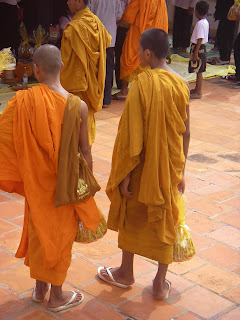
In the UK, a typical funeral ceremony is held 1-2 weeks after the death, a wake proceeds the ceremony when family and friends toast the deceased, wonder why they haven’t seen each other since the last family wedding/funeral/christening, inevitably drink too much and after paying their respects to the closest family members of the deceased, leave until the next family wedding/funeral/christening. Here in Cambodia there seems to be a lot more to it. As soon as possible after death, the body is burned and a 2 or 3 day ceremony is held, depending on the wealth of the family. But that’s not the end of it: after 7 days another 2 or 3 day ceremony is held, then again after 100 days and then again after 3 years. Originally I thought this seemed a little excessive, if not expensive, but I’m coming round to the idea that it might be a good way of easing the grieving process, remembering the deceased and their family and it’s a good excuse for a get-together.

I was invited to attend part of the 3 year ceremony for the dead grandfather of one of my colleagues, 24 year old Daney. The whole family turned up from as far away as Phnom Penh and almost the whole village were there as well. I recognised that he must have been quite a popular man, but then again the whole village seem to be related to each other in some way or other.

Monks came to the house where a shrine to Daney’s late grandfather was erected. They chanted a lot of monotone Khmer, none of which I understood, musicians were also present playing traditional ceremonial music and the place was a mass of mainly women dressed in black sampots, white tops, toothless and with shaved heads. I believe these women live at the local pagodas and are widows, many of which have no family hence the pagoda is their home. 'Lay women' was the word translated to describe them. We then ate a lot of food and were slowly organised into a procession line to follow the ‘relic’ of Daney’s grandfather being carried to the local pagoda.



The relic is a small collection of bones which didn’t manage to get burnt when the body was cremated. They are kept in a small urn, in this instance in a glass case. Once at the pagoda the closest family members carried and some followed it around the family stupor 3 times before it was placed inside the stupor with a lot of chanting, prayers, incense and offerings of water and food. Fascinating to watch. Then there was more monk chanting and the family gave more offerings to the orange clad fellows. Then everyone drove back to the house for more food.

It was a sombre occasion in a sense but also a celebration. It really was quite amazing to witness, surrounded by a sea of shaved grey heads, black, white and orange, although I can imagine it would be a real bind if you didn’t much like the deceased!
 A lot of value is placed upon appeasing the spirits of the dead which isn’t particularly Buddhist as I understand it but rather derives from animist beliefs which were absorbed into the country’s national religion along with a hangover of Hinduism way back when.
A lot of value is placed upon appeasing the spirits of the dead which isn’t particularly Buddhist as I understand it but rather derives from animist beliefs which were absorbed into the country’s national religion along with a hangover of Hinduism way back when. 






No comments:
Post a Comment